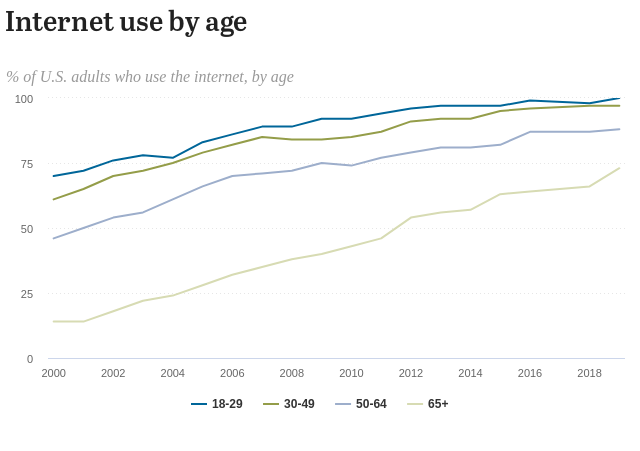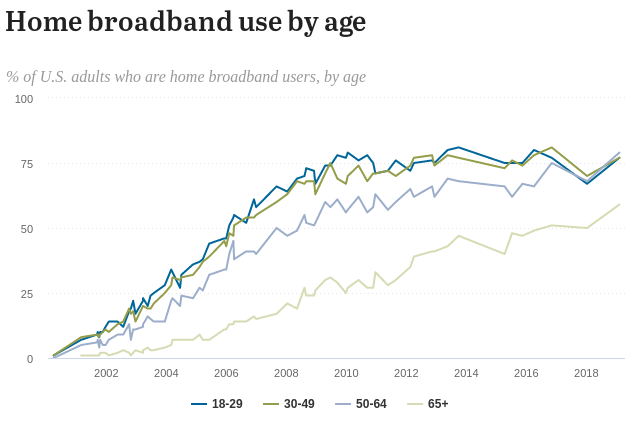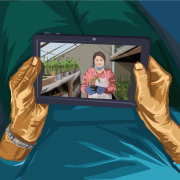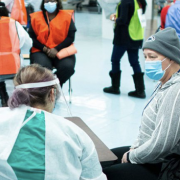People With Dementia Are Twice as Likely to Get Covid, Huge Study Finds – The New York Times
/in 2021, MS NEWS /by adminWorking to Connect Older Adults
/by adminLESSONS FROM THE PANDEMIC
Working to Connect Older Adults
A Digital Inclusion Progress Report

By Susan Nash, Consulting Research Scholar, Stanford Center on Longevity
Imagine sheltering in place for a year, or more, without internet access. That is the situation for nearly 15 million adults aged 65 and up, or over one-quarter of the older population in the United States, estimated to be off-line.1

Source: Pew Research Center. Surveys conducted 2000-2019. Data for each year based on a pooled analysis of all surveys conducted during that year.
Even for those who do go online, 41 percent of adults 65+, over 21,000,000 people, do not have home broadband access.

Source: Pew Research Center. Surveys conducted 2000-2019. Note: The Center has used several different question wordings to identify broadband users in recent years, which may account for some variance in broadband adoption figures between 2015 and 2018. The survey conducted in July 2015 used a directly comparable question wording to the one conducted in January 2018.
If nothing else the pandemic has shone a much-needed light on this other digital divide. As they shelter in place, those without reliable or indeed any internet access may be dealing with both social isolation, especially among the 14 million-plus who live alone, and the practical challenges of life during a pandemic, such as ordering groceries and obtaining health care via telemedicine.
While attention to the lack of digital inclusion is both welcome and overdue, the prospect of connecting and training the very people who, because they are the population most at risk, must most stringently avoid in-person contact is daunting. So it is encouraging to see the number of local governments, nonprofits and public/private partnerships that are trying to help.
These efforts include providing older adults with the full “3-legged stool” of broadband, devices and training, arranging more limited access through specially modified tablets or re-purposed devices, teaching those who do have connectivity how to use voice-activated virtual assistants, and even low-tech solutions using television programming or regular telephone calls. The following is a sampling of innovative strategies across the country to address this problem. (See Table 1 for local efforts in the Bay Area.)
Imagine sheltering in place for a year, or more, without internet access. That is the situation for Nearly 15 million adults aged 65 and up, or over one-quarter of the older population in the United States, estimated to be off-line.
Broadband Access, Devices and Training
National nonprofit Older Adults Technology Services (OATS) is using a $3 million investment from The Humana Foundation to launch Aging Connected, a consortium for accessible internet connections for older adults. Aging Connected will focus on getting at least 1,000,000 older adults online by June of 2022, particularly those in marginalized communities. The consortium will include technology companies, nonprofit senior services providers, and public sector agencies. Earlier this year, OATS’ Senior Planet program worked with the New York City Housing Authority and private companies to deliver 10,000 internet-connected tablets, along with a year of free tech support, to older adults living alone in public housing throughout the City.
Virtual Assistants
A less labor-intensive way of connecting older adults is through the use of virtual assistants such as Amazon’s Alexa and Google Assistant. These voice-activated devices, which require a Wi-Fi connection, can perform a variety of functions, from reminders to take medications to playing games, and can converse in multiple languages. The devices can also connect older people to family members and friends. AARP Foundation, through its Connect2Affect program, is supporting the use of Alexa-type devices in senior housing communities, along with a community management platform that allows residents to find out about community activities. Front Porch, after conducting a pilot project in San Diego, is now installing these devices in many of its California communities. These voice-activated technologies allow even the oldest old and those with visual or hearing impairments to use technology to improve their quality of life.
Telemedicine
Social isolation is not the only issue that drives efforts to connect older adults. The Center for Connected Health Policy estimates that 34,538,375 telehealth services were delivered from March through June 2020, an increase of 2,632 percent over the same period in 2019. Older adults, though, continue to lag behind in adopting telehealth; a recent study found that 38 percent of older adults in the U.S. (about 13 million) are not ready for video visits mainly because of inexperience with technology. Among Medicare beneficiaries, over 26 percent lacked any form of digital access (smartphone or laptop) at home, a percentage that is even higher among those living below the federal poverty level (50.1%) or over 85.
As one effort to respond to this need, a group of college and high school students has formed Telehealth Access for Seniors, a nonprofit that so far has distributed 2500 repurposed devices through doctor’s offices and clinics, including Veteran’s Affairs hospitals, in 26 states. The devices come with instructions in five languages and free tech support from volunteers. The volunteers have also helped older adults expand their use of the devices to order groceries and use Zoom and FaceTime. Older adults needing online access are identified by their medical providers, overcoming the hurdle of finding people who are not online.
“Old” Technology”
Of course, not all older adults want to go online at all, due to fears of online fraud or just a lack of interest in adopting a new technology. Seattle is reaching out to this group through a much older technology, television. AgeWise TV – a series of programs curated for older adults – began airing on The Seattle Channel on June 25, 2020, with the goal of serving older adults no longer able to gather at senior centers closed because of COVID-19. Offerings include chair yoga and histories of Seattle landmarks like the Space Needle.
Papa, an organization founded in 2018 to provide “family on demand” by pairing older adults with younger workers and college students who share common interests, has switched to telephone calls or Facetime to continue or start new connections. Some “Papa pals” also run errands and pick up groceries.
This panoply of options is playing out against a backdrop of state and national efforts to provide more broadband access in rural and underserved communities and an expansion of free hot spots offered by libraries and others. As more Wi-Fi hot spots and cheaper broadband become available, the question will be how to make meaningful progress in actually connecting and engaging older people in ways that make their lives better. There is no one-size-fits-all solution, so the more creative efforts like those happening during the pandemic, the better.
Table 1. San Francisco Bay Area Efforts To Expand Digital Access and Connection for Older Adults:
Organization | Plan/Project |
Community Tech Network Created a Home Connect program to provide internet access, devices and virtual training to older adults in the Bay Area and Austin, TX | |
Mon Ami Operating volunteer phone bank to connect older adults with companions and has donated volunteer matching technology and smartphone app to the City of San Francisco and other local governments to help with volunteer response during the pandemic | |
San Francisco Tech Council Launched in April 2015 to coordinate and support efforts to improve digital access and training for older adults and people with disabilities | |
San Jose Digital Inclusion Fund Plans to distribute $24 million in grants over a 10-year period to address the digital needs of underserved residents, including older adults. The first $1 million in grants was disbursed earlier this year | |
Santa Clara County Digital Inclusion Workgroup Working pursuant to a County Board of Supervisors mandate to increase countywide collaboration on, and find options for, digital inclusion for older adults Note: The author is a member of this volunteer group. | |
Sourcewise (Santa Clara County’s designated Area Agency on Aging) Has $125,000 in funding available to support up to three agencies to help adults 60+ with internet access, devices and training during the COVID- 19 pandemic | |
TeleVisit Offers programs to engage older adults and provide social connection from home using a telephone or a specially designed internet-ready tablet that requires minimal training to activate |
< Back to main page | Read more research and articles about bridging the digital divide>
1 https://www.pewresearch.org/internet/fact-sheet/internet-broadband/













